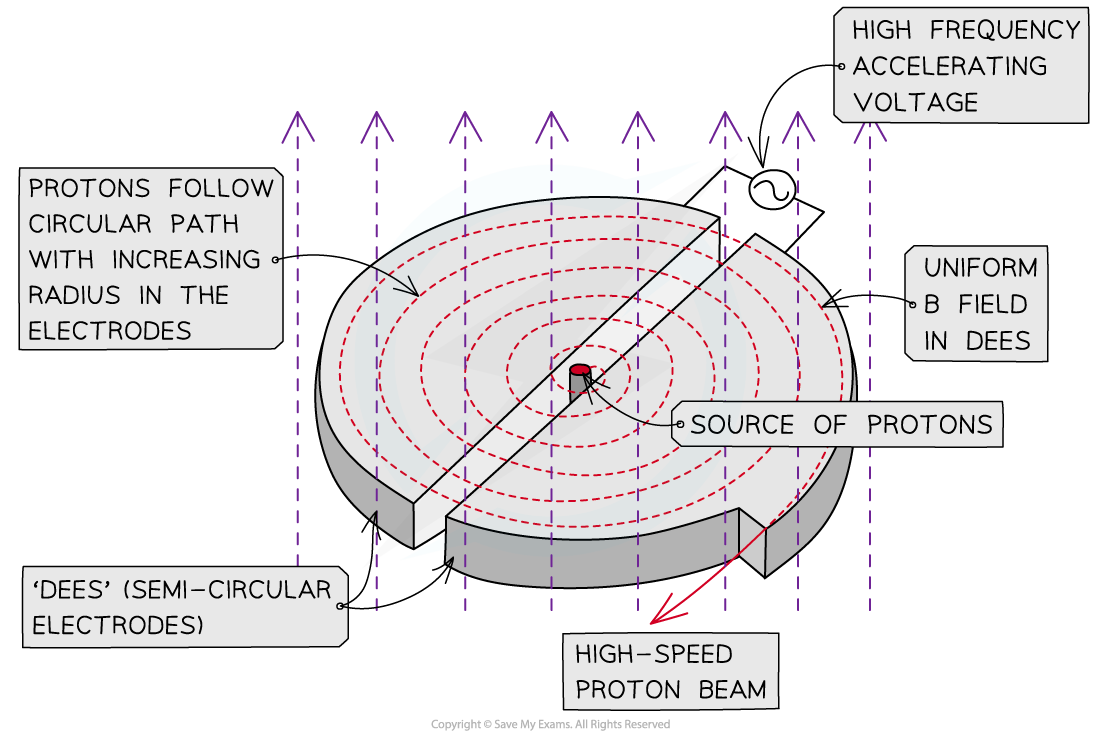Particle Accelerators & Detectors (Edexcel International A Level (IAL) Physics) : Revision Note
Particle Accelerators & Detectors
Linear Accelerators
A linear accelerator (LINAC) is a type of particle accelerator that accelerates ions (charged particles) to very high speeds in straight lines
LINACs use electric fields within and between metallic tubes which act as oppositely charged electrodes
The high-energy ions produced are used in collider experiments
These experiments enable the internal structure of atoms and subatomic particles to be investigated
LINACs are comprised of a series of hollow cylindrical tubes

Linacs accelerate ions through progressively longer tubes, connected to an alternating power supply. This ensures they are always accelerating from one tube to the next
An AC power supply is connected across each tube to ensure ions are always accelerated from one to the next
The ions will be attracted to the midpoint of a tube
At this point, the AC supply will switch such that the ions are repelled to the exit, and attracted to the next tube
This process continues in a straight line all the way to the end of the accelerator
The frequency of the AC supply is fixed
This means the polarity (positive or negative charge) of each tube switches at a constant rate
Therefore, each tube must be built successively longer
This is because the ions are speeding up
Hence, this ensures ions spend the same amount of time under acceleration in each tube
Cyclotrons
A cyclotron is a type of particle accelerator that accelerates ions from a central entry point around a spiral path
They are used for medical research such as:
Producing medical isotopes (tracers)
Creating high-energy beams of radiation for radiotherapy
Cyclotrons are comprised of:
Two hollow semicircular electrodes called 'dees'
A uniform magnetic field applied perpendicular to the electrodes
An AC power supply applied across each dee, which creates an electric field in the gap between them

A cyclotron uses magnetic fields and electric fields to accelerate charged particles, like protons. The magnetic fields keep protons in a circular path, and the electric field increases their speed
The process of accelerating an ion in a cyclotron is:
A source of charged particles is placed at the centre of the cyclotron and they are fired into one of the dees
The magnetic field in the electrode makes them follow a circular path, since it is perpendicular to their motion until they eventually leave the electrode
The potential difference applied between the electrode accelerates the ions across the gap to the next dee (since there is an electric field in the gap)
In the next dee, the ions continue moving in a circular path within the magnetic field
The potential difference is then reversed so the ions again accelerate across the gap
This process is repeated as the particles spiral outwards and eventually have a speed large enough to exit the cyclotron
The alternating potential difference is needed to accelerate the particles across the gap between opposite electrodes
Otherwise, the ions would only speed up in one direction
Particle Detectors
When charged particles move through any medium, such as a gas, they transfer energy to it
This is usually through the process of ionisation
High-energy ions transfer some of their energy to surrounding atoms, removing electrons
The ions and electrons produced are then accelerated by applied electric fields
Once these are discharged they form pulses of electric current
Each pulse of electricity is counted by electronic counters connected by electrodes
'Counts' are then interpreted as detection of individual particles
Ionisation is the principle by which many particle detectors operate, such as in:
Geiger-Muller tubes
Spark chambers
Gas and cloud chambers
The particles are sometimes deflected meaning they are also scattered
This can cause multiple scattering of the particle in the material
Examiner Tips and Tricks
Make sure you can distinguish between the two types of particle accelerator: remember, LINACs only use electric fields (to accelerate ions in straight lines) whereas cyclotrons use both electric fields and magnetic fields.
In particle detectors, you only need to describe the two key principles which allow scientists to detect particles: ionisation and deflection (by applied electric fields).

You've read 0 of your 5 free revision notes this week
Sign up now. It’s free!
Did this page help you?
